In 1938 John W. Campbell wrote a creepy as all hell science fiction story titled Who Goes There?, about a team in the arctic who discovers a spaceship they estimate was buried in the ice twenty million years ago, and its pilot, some kind of hideous thing, frozen nearby. They cart the thing back to camp encased in a block of ice and debate the finer points of thawing it out. Will its cells return to life if warmed up? Will the thing itself wake up? Will it infect humans with spacegerms? Will Earth germs infect and destroy it?
They decide to defrost it. And while they sleep, the thing wakes up. They find it attacking their sled dogs, and burn it to death. Studying the remains, they come to understand that the thing was imitating the dogs, becoming them. A more disturbing realization sinks in: the thing may have already imitated one of the men. If it reaches civilization, it could assimilate all life on Earth.
The men turn on one another, not knowing who is human and who is the thing. It’s a scary, claustrophobic story that’s endured in the science fiction canon since its publication. Campbell originally wrote it under a pseudonym, but published it under his own name in a book including other stories in ’48, which featured this amazing artwork on the cover by artist Hannes Bok.
Campbell’s story was a natural for the movies. The golden age of science fiction arrived at the end of the ‘40s, and in ’51 three future-classics of the movie space-age were released, The Day The Earth Stood Still, When Worlds Collide, and the first adaptation of Who Goes There?, The Thing From Another World.
Special effects of the time precluded the filmmakers from showing a three-eyed, shape-shifting, monstrous beast consuming dogs and men with oozing protoplasm, nor could they show imitation men growing hair and claws, melting into cellular goo, and infecting other men. They couldn’t show a murder victim with a slashed throat coming back to life and being hacked in half with an axe and set on fire. What they could do was dress up actor James Arness in a Frankenstein costume and have him stomp around, moaning and clawing people.
The Thing From Another World was produced by Howard Hawks, hugely famous director of movies such as Scarface (’32), Bringing Up Baby, His Girl Friday, The Big Sleep, Red River and many more. Although The Thing From Another World was directed by Christian Nyby, it has long been assumed that Hawks himself was calling the shots. Hawks and Ben Hecht, uncredited, re-wrote the screenplay by Charles Lederer, and all of the dialogue is of the wacky, snappy, romantic comedy variety. Which is a little off-putting in what’s supposed to be a horror movie. But such were the times.
The movie doesn’t follow the original story at all, aside from the basic set-up, and the bit where they accidentally blow up the entire spaceship when their thermite explosives ignite the magnesium the ship is made out of. Oops. The discovery of the spaceship is one of the best moments, as the men, seeing a strange plane under the ice, spread out to find its edges, then turn to find they’re stading in—a circle! At which they cry with delight at having found a flying saucer.
As for the thing, they bring it back to camp and accidentally defrost it, whereupon it escapes, attacks the dogs and drinks their blood, for it seems this thing is made entirely of vegetable matter, yet feeds on blood. The best line of the movie is delivered by a reporter who happens to be at the station (all ‘50s sci-fi movies contain a reporter nearby): “An intellectual carrot. The mind boggles!”
Also in keeping with the times—the beginning of the atomic age—the scientist in the movie, Dr. Carrington, wears a goatee, looks suspiciously foreign, and is entirely evil, even going so far as to suggest allowing the thing to kill them all if it means its survival, for after all, it is the first and only specimen of life from another planet. In secret he gathers spores from the thing’s severed hand and grows them, feeding them from bags of blood plasma. Most disturbing of all, he’s always on about how perfect an organism the thing is, how it doesn’t need to have sex to reproduce (thank heavens!), how it doesn’t know pleasure or pain. Dr. Carrington is essentially a disturbed, sexless robot, prefiguring the evil robot scientist Ash in Alien (’79).
It’s up to the air force captain played by Kenneth Tobey to take charge, with his clean, crisp militarism, and cook that damnable walking vegetable to death. They rig up a sort of electrical trap and fry the thing in a cool scene featuring multiple arcs of electricity and the thing melting in a very Wicked Witch kind of way. The movie ends with the reporter dictating his story of the affair over the shortwave radio, ending with his famous line, “Watch the skies, everywhere. Keep looking. Keep watching the skies!”
Unless you’re under 10, The Thing From Another World isn’t going to scare you these days. But it remains entertaining, if not a bit silly. One of its coolest effects is the title of the movie. It appears as if ripped out of the screen by beams of light.
One of the ways John Carpenter paid tribute to the original movie when he made his version in ’82 was to create the same kind of effect with the title. Here’s how Peter Kuran, the special optical effects supervisor, said he managed it:
When I did the effect for the title I used…a fish tank that was about four feet wide by two feet high. I put smoke in the fish tank and on the back of the tank I put the title that was drawn on an animation cel, and behind that I had a piece of plastic garbage bag which I stretched over a frame, and behind that I had a light pointing through the letters. When I photographed it, I put a flame from a match to the plastic. The plastic would open up and let the light through the letters. That is how the letters look like they form and burn on with the rays.
Another little nod to the original is when the thing, set on fire by a flamethrower, bashes it’s way out of the station into the night. The same thing happens in the original, as well as in the ’11 remake/prequel.
Though Carpenter’s The Thing is considered a remake, it’s a completely different movie that hews much closer to Who Goes There?, reflecting the book’s mood, characters, style, and of course the nature of the thing itself, presented with the best in goopy monster effects by the young and highly creative Rob Bottin, with one sequence (the dog transformation) by Stan Winston. Furthermore, The Thing in a sense acts as a sequel to the original movie in that the characters in this movie don’t make the initial discovery; the thing comes to them.
I love the opening shot of The Thing. A static shot of an icy ridge, waiting for something to happen. A helicopter flies into view. It’s following a dog running through the snow, and the men in the ‘copter are shooting at it. They come to U.S. Outpost #31. One of the men accidentally blows himself up while the other is shot. The dog lives and is taken in.
It’s one hell of a creepy dog. There’s this one shot where it ever so slowly enters a hallway that’s inexplicably unnerving. Something about how slowly it appears in the doorway, or how methodically. The dog walks into the hallway, pauses, looks into one room, keeps walking, pauses to look into another room where it sees the shadow of a man, and enters the room. Carpenter said the dog did this in one take. If only all actors nailed their marks this perfectly.
MacReady (Kurt Russell) and a couple of the other men fly to the nearby Norwegian outpost (the two guys in the ‘copter were Norwegian) and find it burned up and deserted. A bloody axe is stuck in a doorway. A man sits frozen, his neck and wrists slashed, the razor stuck in his hand. In a back room sits a huge block of ice with a suspiciously empty hole in its center. And in the snow they find the partially burned remains of something horrible. What I love about this sequence is that MacReady and the others are seeing their own future without realizing it. It’s a frozen tableau of what’s to come. The Norwegians found the spaceship and the thing that crawled out of it. U.S. Outpost #31 contains the thing’s second set of victims.
The rest of the movie follows the book, more or less. The thing attacks. The scientist Blair (Wilford Brimley) figures out what it’s up to and goes nuts. The men realize that some among them must be things. No one trusts anyone. A blood test is devised to see who’s human and who’s a thing. It’s a slow-burning movie, growing steadily more tense and grim. Once the thing cuts the power, the men know they’re going to freeze to death, and hope that by burning the station they can at least take the thing with them. In the end only two men are left, MacReady and Childs (Keith David). They huddle up in the cold as the station burns, waiting to die, not knowing if the other is human or monster.
It’s about as dark an ending as possible, not at all the same as the book, where the men defeat the thing at the last moment, just as Blair—turned into a thing—is about to launch a small craft to take him to civilization. Carpenter is fond of bleak, nihilistic endings. His previous movie, Escape From New York (’81), ends with Kurt Russell effectively allowing world war III to erupt out of pure spite.
The Thing didn’t fare well in the summer of ’82. Up against E.T. and other flicks for the kids, it didn’t have a chance. Also unhelpful were the critics, who mostly hated it. As a demented 11 year old myself, I loved it, and could not fathom why everyone was fawning over E.T. when here was this movie where a guy’s head slithers off his body, sprouts legs and eye stalks and skitters across the floor. What more could you ask for? Critics couldn’t get away from the gore, bitching about the lack of subtlety or some shit. Did they want James Arness in his giant carrot suit? Was that subtle and suspenseful? According to the science fiction literati of the time, apparently so. What they failed to see was the creativity of the effects. There’s been nothing like it since. The movie endeavored to show how this creature that consumes and imitates other life forms might actually look, and they went all out.
Carpenter was hugely depressed at the movie’s initial reception. He knew how good it was. Why didn’t everyone else? Fortunately, since ’82 The Thing has found its audience (just like another summer ’82 movie that bombed when it opened on the very same day as The Thing, Blade Runner). It’s beloved, even. Compared to much of the horror and science fiction dreck of today, it’s a deliberately paced, taught, scary movie, with some of the most imaginative horrific effects of all time. Though at the time critics swept it up into what they saw as the moronic movies of the ‘80s, The Thing stems from the bleak style of the ‘70s.
So beloved is The Thing nowadays, that the genius producers who gave us the Dawn of The Dead remake decided to shit all over it. It would be a prequel, set at the Norwegian camp that first discovered the spaceship. Which okay, why not? That actually might be fun, getting to watch how the wrecked camp came to end up the way it did. It’s even kind of cool knowing that the movie will end with two survivors chasing a dog in a helicopter.
Does this guy with that hand look familiar? Sure, use an image from the last movie to sell your new one.
It didn’t work out that way. The Thing (’11), which let’s call Thing Two from now on, is so bad that it’s not even especially bad. What it is is no fun at all. It’s a perfectly competent, modern day sci-fi flick, full of state-of-the-art CGI effects, bland acting, and a safe, corporate feel. It’s hard to be mad at something so machine-like and lifeless. It’s like yelling at a rock you find somewhat ill-formed. What’s the point?
The saddest part about watching Thing Two for me as a writer, and as someone who loves Carpenter’s movie dearly, is how seemingly uninterested the filmmakers were in creating the connective tissue between movies. It’s as though by throwing in a few key elements that they’ve done their job of pleasing fans of the last movie and can move ahead with their own. But they have no movie of their own. All they have is a re-tread of The Thing.
The biggest problem they face is that The Thing does a great job of thinking through what the men would do faced with this situation. They do what’s smart. In Thing Two, how do you not just replay all the same scenes without your characters looking dumb? I’m not sure, and neither were the filmmakers. It’s the same movie, only everyone’s dumber. Not to mention anonymous. All the Norwegians blend together. Not a single one has an indentifiable personality. There’s an American woman on hand, Kate (Mary Elizabeth Winstead), who takes charge by, I don’t know, yelling and looking intense, I guess, who’s really only distinguishable from everyone else because she’s in all the scenes.
Then there’s the CGI effects. They look good enough. Problem is, this new version of the monster moves fast, jumps all over the place, and can do anything instantly. Which kills the suspense. In The Thing, and in Who Goes There?, the monster is smart but vulnerable. Imitating other life forms is how it hides. That’s its defense mechanism. When it transforms it’s weak and can be attacked. It has to be careful. It has to be smart. The way it’s portrayed in Thing Two, there’s no reason it doesn’t just attack everyone at once and be done with it. Instead, it’s slow or lighting fast depending only on the demands of the script. There’s no logic to it, there’s no tension, there’s no drama. At one point the thing reveals itself inside a flying helicopter, causing it to crash. It’s the dumbest monster in the universe.
So let’s see. The axe in the door. Someone trying to get in? Out? Nope. A guy cuts in half a spidery thing running around. Then leaves the axe. The awesome stretchy-faced creature? Turns out it’s actually two different heads fused together. Which it obviously wasn’t in The Thing. And it doesn’t look anything like what we saw in The Thing. Nice work there.
How about the guy who slashed his own throat? If I wrote this movie I’d be so excited about that character. I’d build him up knowing he was going to kill himself so dramatically. Was the thing right in front of him when he did it? Was it only a friend he suspected? So many possibilities! Which do they choose? How about none of the above? His suicide happens off-screen. We only see him later, already frozen. Which character was it? I honestly have no idea. One of the interchangeable Norwegians.
Finally there’s the helicopter and the dog. But first our seemingly last two survivors, Kate and some guy, end up back at the spaceship in the ice, to which the thing has absconded, and managed to power up. Kate blasts the thing, disables the ship, and gets back to the snowcat with her pal—who turns out to be a thing! Yikes! She kills him and sits there. Cut to black.
Really? That’s an ending? Is that supposed to mimic The Thing’s bleak finale? Because it doesn’t. It has no meaning at all. It’s fucking stupid, is what it is. Is she going to drive somewhere? Can she? Can’t she? Is this movie related to Carpenter’s? She can’t live, or the world would know everything. She can’t stay there because there’s no snowcat with a dead American woman in it when Kurt Russell and team show up. So there is no ending. The movie just stops. But what about the helicopter?
Hold on, there’s a last scene, the next morning. Random guy turns up in a helicopter. Random Norwegian is still alive. And a dog runs out of the building! Off they go chasing it.
Holy god what a mess. Too bad we don’t know shit about the characters chasing the dog. Too bad it makes no sense that a guy who just showed up would suicidally pursue a dog to his own death. But the filmmakers don’t care, so why should I?
Okay, everyone hated The Thing when it came out, and now they love it. How about Thing Two? Will it become a classic twenty years down the road? I am skeptical. There is no love in this movie. There is no passion. There is no personality. Is has no meaning, no style, and no reason for existing. It adds nothing to the lore of this story. It is a sorry rehash of what came before. Even its title card sucks:
If you really wanted to make another version of Who Goes There?, you could. The one element of the book no one used in the movies is the telepathic one. In the book, as soon as the men encounter the ship and the thing, they begin to experience what at first seem like nightmares of the monster, but which they come to realize are projections sent by the thing itself. It’s inside their minds. It has to be, since not only does it imitate their physical bodies, it imitates who they are, their personalities, their behavior. Someone with imagination could take this element and spin it into a very different kind of movie, a sort of weird-ass fusion of Who Goes There? and Stanislaw Lem’s Solaris.
That’s a lot of words on one 76 page story from ’38 and what it’s inspired. It’s not like the writing is brilliant. The suspense is a little half-assed, and the characters are a bit goofy here and there. It works because it’s fundamentally terrifying. A thing that could be anyone, that if it isn’t stopped will eventually be everyone, and every living thing besides. It clearly inspired Jack Finney’s ’55 novel The Body Snatchers, which itself has spawned four movies.
Obviously I like Carpenter’s take the best. I’ve seen it, well, disturbingly often. If you haven’t watched it since ’82 or so, it’s worth another look, and so is The Thing From Another World. As for the latest remake, it should, and will be, forgotten. With any luck, someone passionate and creative will one day come along and find a new way of telling this story.











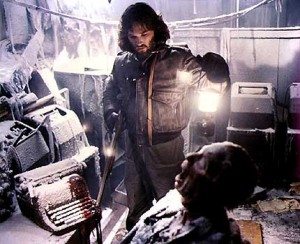

I watched Carpenter’s The Thing earlier this year for the first time. Blown away. My favourite thing about was the way that the seeds of mistrust slowly destroy the group. Quite nihilistic.
Loved it
great write up btw
thanks. i always loved both the earlier versions. i’d heard the new one was awful, but curiosity got the best of me. i was hoping it would at least be so bad it was fun. but alas, it was not to be.
i can live without John Carpenter and Kurt Russell but The Thing is aces. One of my favorite horror films easily. I do not have the heart to watch the new one. It sounds depressing.
There’s a cool sci-fi story out there in which someone rewrites John Carpenter’s The Thing from the The Thing’s point of view. I enjoyed it.